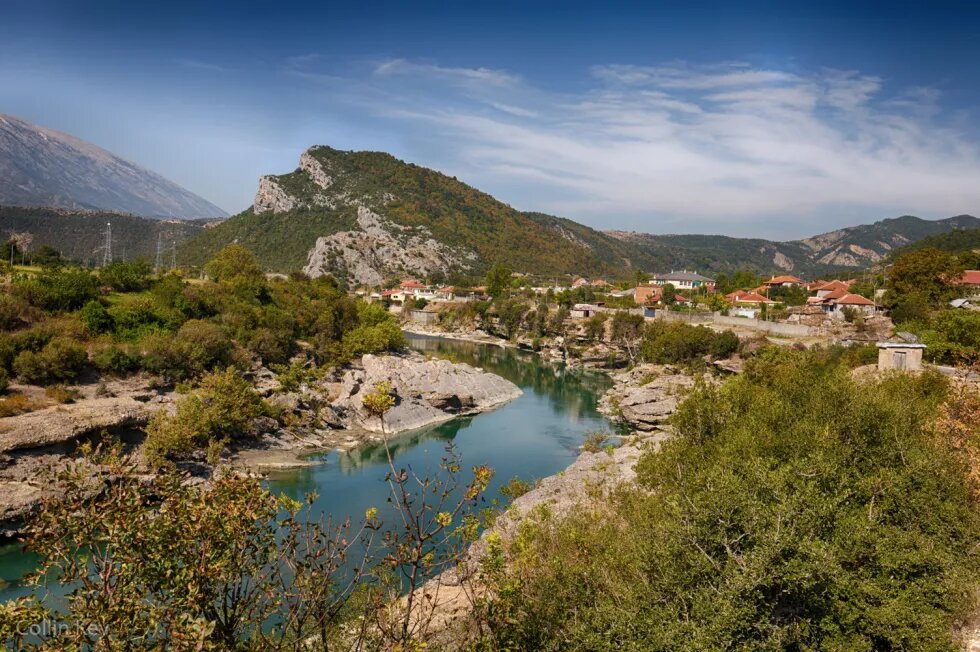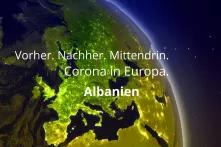Back to www.boell-bw.de
Vjosa, in south Albania, is one of the most renowned rivers in Albania, in terms of the natural heritage and biodiversity values that it sustains. The diverse geological formations, reliev characteristics and climate conditions of the Vjosa basin have contributed to an enormous diversity of habitats and species, many of which remain undiscovered to this day. Vjosa’s abundance with fish, including its estuary and the Narta lagoon, make the region quite important for fishery and many local inhabitants have build their livelihoods based on fishing, which continues with largely traditional practices to this day.

Vjosa, in south Albania, is one of the most renowned rivers in Albania, in terms of the natural heritage and biodiversity values that it sustains. It flows for 270 kilometres from the Pindos mountains in Greece down to the outflow in the Adriatic sea, north of the Narta lagoon in west Albania. Its catchement is one of the largest in Albania with a total area of 6704 square kilometres (of which 4365 square kilometres in Albania and the rest in Greece) and it includes some of the most impressive mountainous chains of the south, including Nemërçka mountain (2485 m), Këndrevica (2122 m) and Çika mountain (2045 m). The entire catchement including the main river and its tributaries is characterised by a very broken terrain, especially in the upper parts, where deep gorges, canyons and rapid flows are common sights. The diverse geological formations, reliev characteristics and climate conditions of the Vjosa basin have contributed to an enormous diversity of habitats and species, many of which remain undiscovered to this day. Many of these are of international importance being protected by a multitude of conventions and international law regimes such as the EU Habitats and Birds Directives. Shumka et al. (2018) in a thorough summary of the diversity values of the Vjosa river catchement report more than 150 species of flora and fauna, which are listed in the Appendices of the Bern Convention. Perhaps one of the most obvious groups of species, for which Vjosa holds a major significance are fish, of which some 31 species have been reported to be present in the river system. Being completely uninterrupted by major human barriers, Vjosa represent a continuous habitat for many fish species, which find here the perfect conditions to feed, reproduce and migrate. The renowned and critically endangered European eel (Anguilla anguilla) finds in Vjosa one of the last and few rivers in which it can conduct undisturbed from human barriers part of its famous long-distance migrations. In addition, several sub-endemic species of fish are present here including the Ohrid loach (Cobitis ohridana) and the Pindus stone loach (Oxynoemachelius pindus) (Shumka et al. 2018). Vjosa’s abundance with fish, including its estuary and the Narta lagoon, make the region quite important for fishery and many local inhabitants have build their livelihoods based on fishing, which continues with largely traditional practices to this day.
The Vjosa basin is the last stronghold of the critically endangered Egyptian vulture (Neophron percnopterus) in Albania. This magnificent bird is the only remaining vulture that still breeds in the country (three other species have gone extinct in the past decades) and the rocky outcrops throughout mountains of the Vjosa valley provide ideal conditions for their nesting. The Drino valley, the largest tributary to the Vjosa, is part of a crucial migratory route for the lesser kestrel (Falco naummani) which gather in thousands in this region before preparing for their annual migration to the south.
More than 250 species of birds have been recorded in the Vjosa basin (Shumka et al., 2018), throughout the variety of habitats it encapsules. The hotspot for birds in the region is the Vjosa delta region, including the Narta lagoon and adjacent wetlands. This complex of wetlands and associated habitats is home to thousands of birds, which find here perfect conditions for breeding, feeding and resting. Each winter more than 10 thousand birds regularly take shelter in the lagoon and nearby habitats, making Narta a site of international significance for migratory birds. Prominent flagship species present here include the Dalmatian pelican (Pelecanus crispus), pied avocet (Recurvirostra avosetta) as well as plenty of herons, cormorants, gulls and terns. A sight to behold are the multitude of greater flamingoes (Phenicopterus roseus) that reside in the thousands in the lagoon and salina and provide an amazing spectacle for the lucky ones to see them when in flight altogether. The Narta Lagoon and the surrounding ecosystem represent one of the largest and most important wetland ecosystems of Albania and the Mediterranean. Besides being part of the Albanian’s Protected Area Network, Vjosë-Narta is part of almost all international ecological networks that a natural site in Albania could be a part of. This wetland is recognized as an 'Important Bird Area' (IBA) and it is recognised as 'Key Biodiversity Area’ (KBA). Vjose-Narta meets all the criteria to be classified as an ‘Wetland of International Importance’ under the Ramsar Convention, which Albania has ratified. It is also nominated by the Albanian government as a candidate site for the Emerald Network under the Bern Convention with an area of 19.412,00 hectares.
More than 200 wild bird species have been recorded in this area (Mladenov et al., 2018; Shumka et al., 2018). From this number, 33 species are listed as threatened on the Red List of Albania Flora and Fauna, with 8 bird species having the status Critically Endangered (CR), 9 classified as Endangered (EN), 13 bird species classified as Vulnerable (VU) and 3 bird species having the status Near Threatened (NT). Moreover, 123 species are listed in the Appendix II of ‘Bern Convention’, which entails that the species are in need of special protection in all range countries of the European continent. Further to that, 7 species are listed in Annex I of the Convention on Migratory Species (CMS), which lists migratory species whose populations are estimated to be threatened partly or in all of their distribution area. Under this convention, Albania has signed the ‘Agreement on the Conservation of African-Eurasian Migratory Waterbirds’ (AEWA), which concerns 92 species found in Vjose-Narta and obliges signatory parties to create or preserve adequate habitat conditions for these species. Meanwhile, with regard to bird populations within the EU, 23 species are of particular conservation interest as their populations have entered one of the threatened lines according to the International Union for Conservation of Nature (IUCN). Finally, 62 species are listed in Annex 1 of the Birds Directive, which obliges member states and those countries that have signed the Stabilization and Association Agreement with the European Union to proclaim Special Protection Areas (SPAs) for these species.
Vjosë-Narta is the most important breeding site in Albania and one of the most important in Europe for several species of Charadriiformes order, which have populations that go beyond 1% of the total population within the biogeographic region. Such is the case of the pied avocet (Recurvirostra avosetta), the breeding population of which, within the Vjose-Narta Protected Landscape, is more than 1% of the total population in the biogeographic region of Southeast Europe, the Black Sea and Turkey. In addition, the area regularly sustains more than 1% of the populations of several species of the Mediterranean and the Black Sea region, such as the Dalmatian pelican (Pelecanus crispus), flamingo (Phoneicopterus roseus) and others.
The diversity of habitats all along the river and in the wider basin area, make for a very high diversity of mammal species too. The globally threatened Eurasian otter (Lutra lutra), finds in Vjosa perfect conditions to live and reproduce and studies indicate that this uninterrupted ecosystem of rivers and streams are likely one of the most important sites for the species in the country (Bego and Hysaj, 2018). The mountainous areas of the basin including the Fir of Hotova National Park, Nemërçka mountain and others are home to communities of large mammals, including the brown bear (Ursus arctos), the grey wolf (Canis lupus), chamois (Rupicapra rupicapra), wild boar (Sus scrofa) and roe deer (Capreolus capreolus). In the coastal areas of Narta and Treporti, sights of the highly endangered monk seal (Monachus monachus) have been observed. Bats also abound in the Vjosa basin with the presence of 29 species (out of 32 evidenced in Albania) recorded so far (Shumka et al., 2018).
To top off the incredible diversity of the Vjosa basin, the presence of more than 1500 species of plants and trees can be mentioned, almost half of the entire species recorded so far in Albania. In addition, some 13 species of amphibians and 32 species of reptiles have been reported as well (ref). The sandy shores west of the Narta lagoon have recently seen attempts of nesting by the globally threatened sea turtle (Caretta caretta) (AdZM Vlore, 2021).
While scientists and conservationists have long louded the unique biodiversity of Vjosa and linked it primarily with the untouched nature of the river, infrastructure development plans seem to go in an opposite direction and disregard the natural heritage of the Vjosa. Plans for hydropower development in the Vjosa have long been known and been subject to opposition by the national and international nature conservation community. The call for Vjosa to become a National Park has been massively supported and has brought to the attention of many people worldwide the need to protect this unique ecosystem. A major breakthrough in the efforts to protect the Vjosa was reached in June 2022, when a memorandum for paving the way towards a future National Park was signed by the Albanian Government (Patagonia 2022). This sign of commitment of the Albanian Government for the protection of Vjosa is, most certainly, putting an end to plans for hydropower development projects in Vjosa, once and for all. Nonetheless, other threats from development plans, perhaps not as known as hydropower, but just as dangerous to the nature of Vjosa, are lurking in recent times. Research on oil extraction in the upper parts of the valley, puts an incredible danger to the nature of the region, should such research lead to the initiation of an oil extraction industry in the future (Taylor, 2021). The plans to build an international airport, the largest in the country, and massive tourism infrastructure (inclusive of resorts and a marina) at the Vjosa delta and adjacent to the Narta lagoon, threaten the integrity of the most biodiverse part of the valley and poses a risk, primarily, for the thousands of birds that inhabit this region. The initial construction works of the airport have recently started, and are already impacting the local flora and fauna to a great extent. The functionality and effectiveness of the future National Park for protecting Vjosa’s natural heritage will be strongly tested, if it has to put up with oil drilling, airport development and tourism infrastructure within its borders or the immediate vicinity.
Dieser Artikel erschien zuerst hier: al.boell.org

